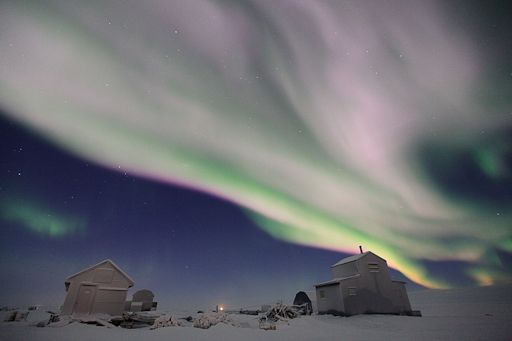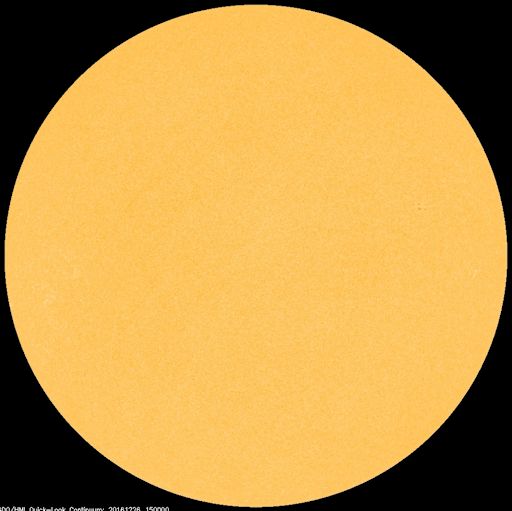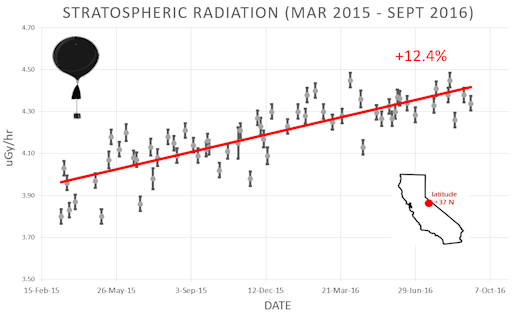Marianne's Arctic Xpress wishes you a Happy New Year. Learn to photograph auroras with the experts. Full photography tuition, all clothing, and semi-pro camera equipment included. Groups of 2 to 8 welcome. Book Now | | | THE SOLAR WIND ON BOXING DAY: For the fifth day in a row, Earth is inside a stream of solar wind blowing out of a large hole in the sun's atmosphere. This is causing magnetic unrest and bright auroras around the poles. Wind speeds are expected to exceed 600 km/s for at least one more day, so Arctic sky watchers should remain alert for auroras on Dec. 26th. Free: Aurora Alerts. I'M DREAMING OF A ... PINK CHRISTMAS? Christmas Day 2016 brought a fantastic display of auroras to the Arctic Circle. A great many of them were pink. James Helmericks sends this picture from the Colville River Delta in northern Alaska: 
"This was the brightest pink display I have ever seen, at one time even giving the snow a pink tinge," he says. The pink color is probably a sign of nitrogen. Most auroras are green--a verdant glow caused by energetic particles from space hitting oxygen atoms 100 km to 300 km above Earth's surface. Seldom-seen pink appears when the energetic particles descend lower than usual, striking nitrogen molecules at the 100 km level and below. Such deep-penetrating particles are being produced by the solar wind stream now blowing around Earth. On the days and nights around Christmas 2016, the pinks became so intense, they appeared white, not only to cameras, "but also to the naked eye," says Sarah Skinner, who witnessed the strange colors several nights in a row from Abisko, Sweden. "It looked like someone had photoshopped the sky!" she says. More examples of this amazing display may be found in the aurora photo gallery: Realtime Aurora Photo Gallery THE SUN IS BLANK: Today, Dec. 26th, the sun is blank for the third day in a row. Not a single dark core can be found in this latest image of the solar disk from NASA's Solar Dynamics Observatory: 
In total, 2016 has had 31 'spotless days'--a whole month's worth. We haven't had this many blank suns in a single year since 2010 (51 days). This is a sign that the sunspot cycle is crashing toward a new Solar Minimum. There are many misconceptions about Solar Minimum. One holds that auroras vanish when sunspots disappear. Christmas Day 2016 was proof that the opposite is true. Without a hint of a sunspot on the solar disk, intense auroras raged around the Arctic Circle on Dec. 25th. What caused the luminous outburst? An enormous hole in the sun's atmosphere directed a stream of solar wind toward Earth, sparking a week-long display that is still underway. Such atmospheric holes are common during Solar Minimum, which is a fine time to see Arctic auroras. Many people think space weather becomes dull or stops altogether during Solar Minimum. In fact, space weather changes in interesting ways. For instance, as the extreme ultraviolet output of the sun decreases, the upper atmosphere of Earth cools and collapses. This allows space junk to accumulate around our planet. Also, the heliosphere shrinks, bringing interstellar space closer to Earth; galactic cosmic rays penetrate our atmosphere with relative ease. Yes, Solar Minimum is coming ... but it won't be dull. Realtime Space Weather Photo Gallery
Realtime Airglow Photo Gallery
Realtime Sprite Photo Gallery Every night, a network of NASA all-sky cameras scans the skies above the United States for meteoritic fireballs. Automated software maintained by NASA's Meteoroid Environment Office calculates their orbits, velocity, penetration depth in Earth's atmosphere and many other characteristics. Daily results are presented here on Spaceweather.com. On Dec. 26, 2016, the network reported 9 fireballs.
(6 sporadics, 3 December Leonis Minorids)  In this diagram of the inner solar system, all of the fireball orbits intersect at a single point--Earth. The orbits are color-coded by velocity, from slow (red) to fast (blue). [Larger image] [movies] Potentially Hazardous Asteroids ( PHAs) are space rocks larger than approximately 100m that can come closer to Earth than 0.05 AU. None of the known PHAs is on a collision course with our planet, although astronomers are finding new ones all the time. On December 26, 2016 there were potentially hazardous asteroids. Notes: LD means "Lunar Distance." 1 LD = 384,401 km, the distance between Earth and the Moon. 1 LD also equals 0.00256 AU. MAG is the visual magnitude of the asteroid on the date of closest approach. | | Cosmic Rays in the Atmosphere |
Readers, thank you for your patience while we continue to develop this new section of Spaceweather.com. We've been working to streamline our data reduction, allowing us to post results from balloon flights much more rapidly, and we have developed a new data product, shown here: 
This plot displays radiation measurements not only in the stratosphere, but also at aviation altitudes. Dose rates are expessed as multiples of sea level. For instance, we see that boarding a plane that flies at 25,000 feet exposes passengers to dose rates ~10x higher than sea level. At 40,000 feet, the multiplier is closer to 50x. These measurements are made by our usual cosmic ray payload as it passes through aviation altitudes en route to the stratosphere over California. What is this all about? Approximately once a week, Spaceweather.com and the students of Earth to Sky Calculus fly space weather balloons to the stratosphere over California. These balloons are equipped with radiation sensors that detect cosmic rays, a surprisingly "down to Earth" form of space weather. Cosmic rays can seed clouds, trigger lightning, and penetrate commercial airplanes. Furthermore, there are studies ( #1, #2, #3, #4) linking cosmic rays with cardiac arrhythmias and sudden cardiac death in the general population. Our latest measurements show that cosmic rays are intensifying, with an increase of more than 12% since 2015: 
Why are cosmic rays intensifying? The main reason is the sun. Solar storm clouds such as coronal mass ejections (CMEs) sweep aside cosmic rays when they pass by Earth. During Solar Maximum, CMEs are abundant and cosmic rays are held at bay. Now, however, the solar cycle is swinging toward Solar Minimum, allowing cosmic rays to return. Another reason could be the weakening of Earth's magnetic field, which helps protect us from deep-space radiation. The radiation sensors onboard our helium balloons detect X-rays and gamma-rays in the energy range 10 keV to 20 MeV. These energies span the range of medical X-ray machines and airport security scanners. The data points in the graph above correspond to the peak of the Reneger-Pfotzer maximum, which lies about 67,000 feet above central California. When cosmic rays crash into Earth's atmosphere, they produce a spray of secondary particles that is most intense at the entrance to the stratosphere. Physicists Eric Reneger and Georg Pfotzer discovered the maximum using balloons in the 1930s and it is what we are measuring today. | | The official U.S. government space weather bureau | | | The first place to look for information about sundogs, pillars, rainbows and related phenomena. | | | Researchers call it a "Hubble for the sun." SDO is the most advanced solar observatory ever. | | | 3D views of the sun from NASA's Solar and Terrestrial Relations Observatory | | | Realtime and archival images of the Sun from SOHO. | | | from the NOAA Space Environment Center | | | a proud supporter of science education and Spaceweather.com | | | the underlying science of space weather |  | Beautyz for top beauty products reviews and their buying guides | | | These links help Spaceweather.com stay online. Thank you to our supporters! | | 
